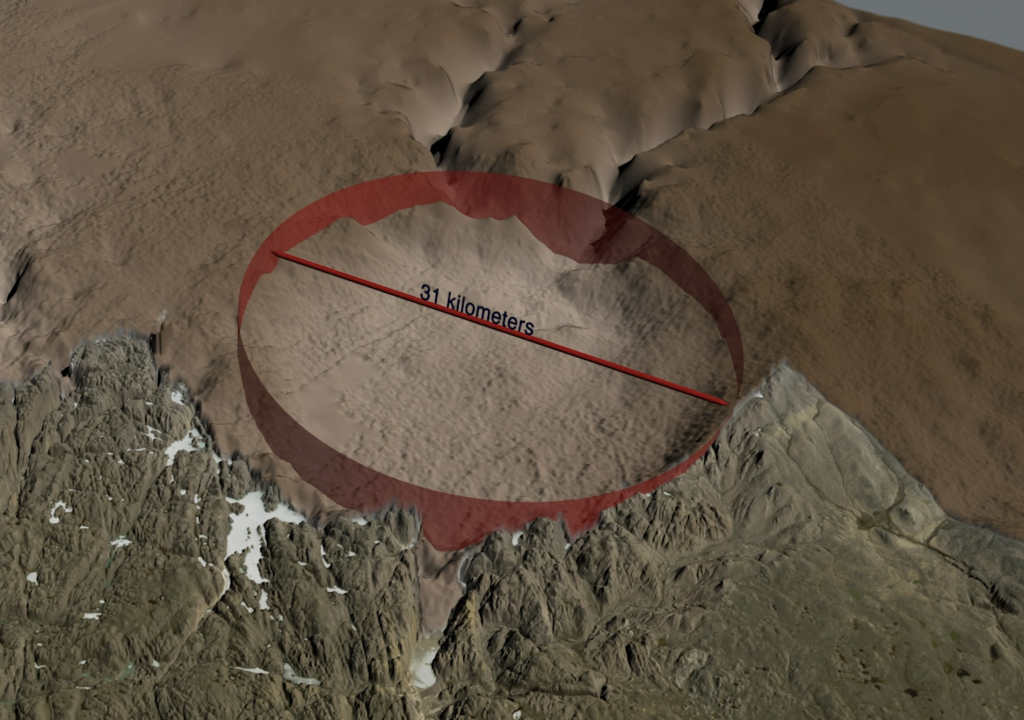Massive meteorite crater discovered underneath Greenland ice sheet
An international research team led by Professor Kurt H. Kjær from the DNRF’s Centre for GeoGenetics is behind the discovery of a huge meteorite crater hidden underneath the ice sheet in Northwestern Greenland. The crater is 31 kilometers in diameter and is believed to be one of the largest and youngest of its kind. The researchers believe that the meteorite’s hit could have had a great impact on climate and may have played a significant role in ending the latest ice age. The study has recently been published in the scientific journal Science Advances.

Professor Kurt H. Kjær from the DNRF’s Centre for GeoGenetics has been in charge of an international research team, including post-doc Anders S. Bjørk, head of center Eske Willerslev, and other colleagues from the center, who have discovered a gigantic meteorite crater buried deep underneath the so-called Hiawatha glacier in Northwestern Greenland. The crater is believed to be one of the biggest and youngest existing meteorite craters on Earth.
“The crater is unusually well-kept and it is surprising, since glacier ice is an extremely effective cutting machine that would quickly be able to erase tracks from the hit. But from a geological point of view, this means that the crater must be relatively young. So far, it has not been possible to date the crater but there is a lot of evidence that indicates it is younger than 3 million years and may have been created 12,000 years ago at the end of the last ice age,” said Professor Kurt H. Kjær, lead author behind the study, from the Centre for GeoGenetics at the Natural History Museum of Denmark.
It is the first time a crater of this size has been found under one of the Earth’s ice caps and the worldwide news has recently been published in the scientific journal Science Advances.
The enormous crater measures 31 kilometers in diameter, which equals the size of Paris or London, which makes the crater the 25th largest of its kind on Earth. The crater was created after a kilometer-long iron meteorite crashed into North Greenland. According to the researchers, the crash happened with such force that it most likely has changed climate and biodiversity in the past.
“The meteorite weighed around 12 billion tons and in terms of energy has elicited 47 million times Hiroshima (dropping of the atomic bomb during World War II). A crash of that volume has great potential to change the climate,” said Professor Kjær to Videnskab.dk
Map revealed crater
The discovery began three years ago when new and more detailed topographic maps of the landscape underneath the ice sheet were available to the Danish part of the research team, which in addition to the Centre for GeoGenetics also includes Aarhus University.
“I saw this new map and thought: ‘It is right here. Here there is a hole in the ground and it must have been a crater, right?’” said Nicolaj K. Larsen, who is a lecturer at Aarhus University’s Institute for Geoscience and co-author of the study.
The topographic maps revealed the circular niche at the Hiawatha glacier in Northwestern Greenland, a discovery that led lecturer Larsen, together with Professor Kjær and post-doc Anders S. Bjørk from the Centre for GeoGenetics, to begin the hunt for evidence that could prove that the circular print was indeed a meteorite crater.
The researchers received help from the Alfred Wegener Institute in Germany and NASA in the US to fly above the crater and scan the area with powerful radar designed to scan landscapes under thick ice layers. That way, the researchers could create an accurate map of the area and collect important and detailed information about the structure of the soil and ice. Later, the researchers revisited the glacier on foot to collect samples from sediments that are washed out from the bottom of the crater through a river of melting water. The results from the samples confirmed that it was a meteorite crater.
Today, we know of approximately 180 meteorite craters on Earth and only a very few are the size of the newly discovered crater in Northwestern Greenland. The researchers suspect that the crater might stem from the famous Cape York meteorite, a fragment of which is located in the yard of the Geological Museum in Copenhagen.
“On the one hand, we have a giant signal in the ice that presumably originates from an iron meteorite. On the other hand, we have Cape York, which was found 300 kilometers south of this crater. It is iron and comes from the same geological period,” said Professor Kjær. He continued:
“The likelihood to have these three factors simultaneously is not that big. But at the same time, we are speaking of a wide geochemical gap and therefore cannot say anything else other than we intuitively want to say that there is a link.”
According to previous studies, large meteorite crashes like the newly discovered crater at the Hiawatha glacier have had large consequences for climate and life on Earth. Thus, it is the researchers’ ambition to date the time of the meteorite crash more precisely.
“The next step in our investigation is to determine the age of the crater. It will be a challenge, since it will demand a specific kind of material from the bottom of the structure but it is crucial if we want to understand the significance of the Hiawatha meteorite in relation to climate and life on Earth,” said Professor Kjær.
Below you can watch the course of the discovery in a video from NASA:
Read the scientific article at Science Advances here.
Read more about the discovery at Science here.
Find more information in a press release from University of Copenhagen here.
Further information on the discovery can be found at New York Times here.
